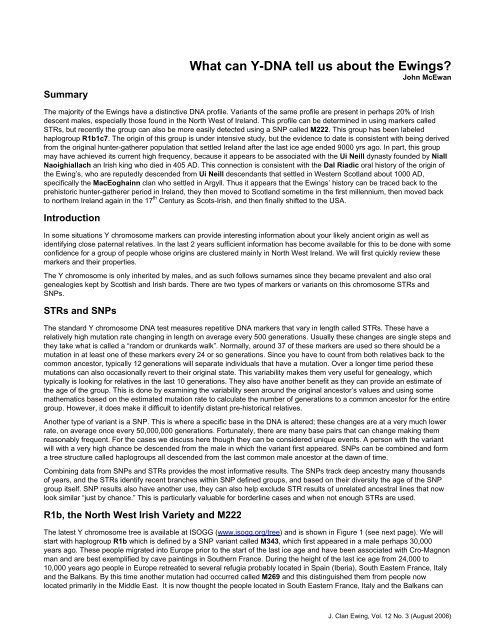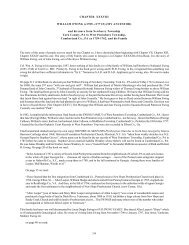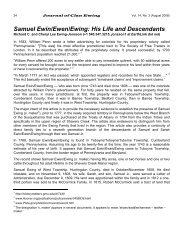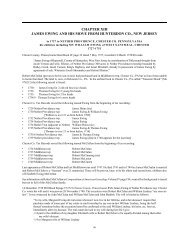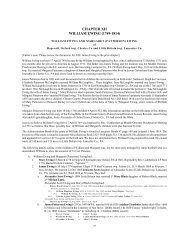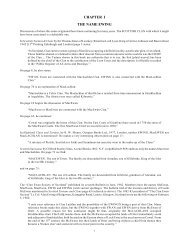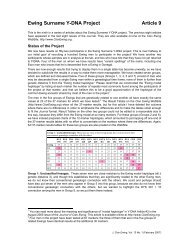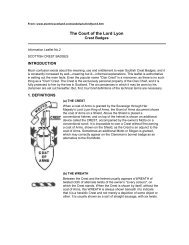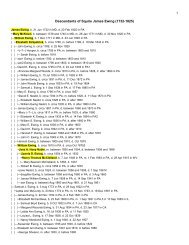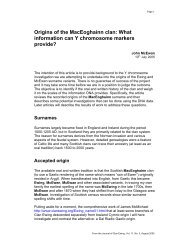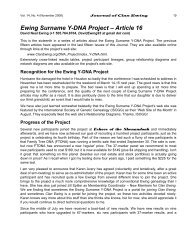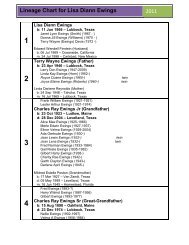What can Y-DNA tell us about the Ewings? - Ewing Family Association
What can Y-DNA tell us about the Ewings? - Ewing Family Association
What can Y-DNA tell us about the Ewings? - Ewing Family Association
You also want an ePaper? Increase the reach of your titles
YUMPU automatically turns print PDFs into web optimized ePapers that Google loves.
<strong>What</strong> <strong>can</strong> Y-<strong>DNA</strong> <strong>tell</strong> <strong>us</strong> <strong>about</strong> <strong>the</strong> <strong><strong>Ewing</strong>s</strong>?<br />
John McEwan<br />
Summary<br />
The majority of <strong>the</strong> <strong><strong>Ewing</strong>s</strong> have a distinctive <strong>DNA</strong> profile. Variants of <strong>the</strong> same profile are present in perhaps 20% of Irish<br />
descent males, especially those found in <strong>the</strong> North West of Ireland. This profile <strong>can</strong> be determined in <strong>us</strong>ing markers called<br />
STRs, but recently <strong>the</strong> group <strong>can</strong> also be more easily detected <strong>us</strong>ing a SNP called M222. This group has been labeled<br />
haplogroup R1b1c7. The origin of this group is under intensive study, but <strong>the</strong> evidence to date is consistent with being derived<br />
from <strong>the</strong> original hunter-ga<strong>the</strong>rer population that settled Ireland after <strong>the</strong> last ice age ended 9000 yrs ago. In part, this group<br />
may have achieved its current high frequency, beca<strong>us</strong>e it appears to be associated with <strong>the</strong> Ui Neill dynasty founded by Niall<br />
Naoighiallach an Irish king who died in 405 AD. This connection is consistent with <strong>the</strong> Dal Riadic oral history of <strong>the</strong> origin of<br />
<strong>the</strong> <strong>Ewing</strong>’s, who are reputedly descended from Ui Neill descendants that settled in Western Scotland <strong>about</strong> 1000 AD,<br />
specifically <strong>the</strong> MacEoghainn clan who settled in Argyll. Th<strong>us</strong> it appears that <strong>the</strong> <strong><strong>Ewing</strong>s</strong>’ history <strong>can</strong> be traced back to <strong>the</strong><br />
prehistoric hunter-ga<strong>the</strong>rer period in Ireland, <strong>the</strong>y <strong>the</strong>n moved to Scotland sometime in <strong>the</strong> first millennium, <strong>the</strong>n moved back<br />
to nor<strong>the</strong>rn Ireland again in <strong>the</strong> 17 th Century as Scots-Irish, and <strong>the</strong>n finally shifted to <strong>the</strong> USA.<br />
Introduction<br />
In some situations Y chromosome markers <strong>can</strong> provide interesting information <strong>about</strong> your likely ancient origin as well as<br />
identifying close paternal relatives. In <strong>the</strong> last 2 years sufficient information has become available for this to be done with some<br />
confidence for a group of people whose origins are cl<strong>us</strong>tered mainly in North West Ireland. We will first quickly review <strong>the</strong>se<br />
markers and <strong>the</strong>ir properties.<br />
The Y chromosome is only inherited by males, and as such follows surnames since <strong>the</strong>y became prevalent and also oral<br />
genealogies kept by Scottish and Irish bards. There are two types of markers or variants on this chromosome STRs and<br />
SNPs.<br />
STRs and SNPs<br />
The standard Y chromosome <strong>DNA</strong> test measures repetitive <strong>DNA</strong> markers that vary in length called STRs. These have a<br />
relatively high mutation rate changing in length on average every 500 generations. Usually <strong>the</strong>se changes are single steps and<br />
<strong>the</strong>y take what is called a “random or drunkards walk”. Normally, around 37 of <strong>the</strong>se markers are <strong>us</strong>ed so <strong>the</strong>re should be a<br />
mutation in at least one of <strong>the</strong>se markers every 24 or so generations. Since you have to count from both relatives back to <strong>the</strong><br />
common ancestor, typically 12 generations will separate individuals that have a mutation. Over a longer time period <strong>the</strong>se<br />
mutations <strong>can</strong> also occasionally revert to <strong>the</strong>ir original state. This variability makes <strong>the</strong>m very <strong>us</strong>eful for genealogy, which<br />
typically is looking for relatives in <strong>the</strong> last 10 generations. They also have ano<strong>the</strong>r benefit as <strong>the</strong>y <strong>can</strong> provide an estimate of<br />
<strong>the</strong> age of <strong>the</strong> group. This is done by examining <strong>the</strong> variability seen around <strong>the</strong> original ancestor’s values and <strong>us</strong>ing some<br />
ma<strong>the</strong>matics based on <strong>the</strong> estimated mutation rate to calculate <strong>the</strong> number of generations to a common ancestor for <strong>the</strong> entire<br />
group. However, it does make it difficult to identify distant pre-historical relatives.<br />
Ano<strong>the</strong>r type of variant is a SNP. This is where a specific base in <strong>the</strong> <strong>DNA</strong> is altered; <strong>the</strong>se changes are at a very much lower<br />
rate, on average once every 50,000,000 generations. Fortunately, <strong>the</strong>re are many base pairs that <strong>can</strong> change making <strong>the</strong>m<br />
reasonably frequent. For <strong>the</strong> cases we disc<strong>us</strong>s here though <strong>the</strong>y <strong>can</strong> be considered unique events. A person with <strong>the</strong> variant<br />
will with a very high chance be descended from <strong>the</strong> male in which <strong>the</strong> variant first appeared. SNPs <strong>can</strong> be combined and form<br />
a tree structure called haplogroups all descended from <strong>the</strong> last common male ancestor at <strong>the</strong> dawn of time.<br />
Combining data from SNPs and STRs provides <strong>the</strong> most informative results. The SNPs track deep ancestry many tho<strong>us</strong>ands<br />
of years, and <strong>the</strong> STRs identify recent branches within SNP defined groups, and based on <strong>the</strong>ir diversity <strong>the</strong> age of <strong>the</strong> SNP<br />
group itself. SNP results also have ano<strong>the</strong>r <strong>us</strong>e, <strong>the</strong>y <strong>can</strong> also help exclude STR results of unrelated ancestral lines that now<br />
look similar “j<strong>us</strong>t by chance.” This is particularly valuable for borderline cases and when not enough STRs are <strong>us</strong>ed.<br />
R1b, <strong>the</strong> North West Irish Variety and M222<br />
The latest Y chromosome tree is available at ISOGG (www.isogg.org/tree) and is shown in Figure 1 (see next page). We will<br />
start with haplogroup R1b which is defined by a SNP variant called M343, which first appeared in a male perhaps 30,000<br />
years ago. These people migrated into Europe prior to <strong>the</strong> start of <strong>the</strong> last ice age and have been associated with Cro-Magnon<br />
man and are best exemplified by cave paintings in Sou<strong>the</strong>rn France. During <strong>the</strong> height of <strong>the</strong> last ice age from 24,000 to<br />
10,000 years ago people in Europe retreated to several refugia probably located in Spain (Iberia), South Eastern France, Italy<br />
and <strong>the</strong> Balkans. By this time ano<strong>the</strong>r mutation had occurred called M269 and this distinguished <strong>the</strong>m from people now<br />
located primarily in <strong>the</strong> Middle East. It is now thought <strong>the</strong> people located in South Eastern France, Italy and <strong>the</strong> Balkans <strong>can</strong><br />
J. Clan <strong>Ewing</strong>, Vol. 12 No. 3 (Aug<strong>us</strong>t 2006)
e identified by two fur<strong>the</strong>r mutations<br />
S21 and S28 respectively. However,<br />
<strong>the</strong> exact history of <strong>the</strong>se groups is<br />
not clear; what is known is that S21 is<br />
now frequent in a band through<br />
Nor<strong>the</strong>rn Germany, North Holland<br />
and S<strong>can</strong>dinavia. In contrast, S28 is<br />
widespread, but seems to have a<br />
focal point in sou<strong>the</strong>rn Germany near<br />
<strong>the</strong> head of <strong>the</strong> Danube and some<br />
have speculated that it is associated<br />
with <strong>the</strong> La Tène Celtic culture.<br />
It is thought that during this period,<br />
due to small population size and relative<br />
isolation, a very distinctive STR<br />
haplotype emerged and ei<strong>the</strong>r during<br />
<strong>the</strong> same phase or j<strong>us</strong>t prior to its<br />
creation a SNP mutation also appeared<br />
called M222. The M222 variant<br />
appeared in individuals that had<br />
<strong>the</strong> M269 mutation, but not <strong>the</strong> S21,<br />
or S28 mutation. Some have speculated<br />
that this group emerged elsewhere<br />
and moved to Ireland. If <strong>the</strong>y did <strong>the</strong>y have left little trace in <strong>the</strong>ir homeland. Until such evidence is found we are better<br />
off assuming <strong>the</strong> mutation and distinctive STR haplotype emerged in Ireland.<br />
This group was initially identified and described by David Wilson based on STR profile alone as <strong>the</strong> Northwest Irish haplotype.<br />
The expanded group was defined by myself based on a different STR results as R1bSTR19 Irish. The different names are<br />
<strong>us</strong>ed to remind people how <strong>the</strong>y have been estimated.<br />
These variants probably only initially accounted for several clans or tribes in Ireland, but <strong>the</strong>y were successful and subsequently<br />
expanded to represent 10-20% of <strong>the</strong> Irish population. This expansion could have occurred at any time, but most likely<br />
during periods of rapid change such as during <strong>the</strong> introduction<br />
of agriculture around 3500 BC or later during <strong>the</strong> bronze or iron<br />
ages. However, by <strong>the</strong> iron age <strong>the</strong> population was already<br />
several hundred tho<strong>us</strong>and people and rising so any later emergence<br />
or expansion of this variant would have required a<br />
marked and s<strong>us</strong>tained advantage extending over perhaps 20<br />
or 30 generations. Later dates require even more improbable<br />
scenario’s. There are only two potential <strong>can</strong>didates for such an<br />
event, virtual elimination of opponents by warfare or <strong>the</strong>ir decimation<br />
by disease. The figures in large STR databases suggest<br />
this groups make up 20% of R1b haplogroup with Irish<br />
male ancestors, 9 percent of Scots, and close to zero in <strong>the</strong><br />
rest of Britain and Europe.<br />
Recent Irish Study<br />
R1<br />
M343<br />
R1b<br />
P25 #<br />
R1b1<br />
M18<br />
M73<br />
R1b1c<br />
M269<br />
M37†<br />
M65†<br />
M126<br />
M153<br />
M160†<br />
M167*<br />
M222<br />
P66†<br />
S21<br />
S26<br />
S29<br />
S28<br />
R1b*<br />
R1b1*<br />
R1b1a<br />
R1b1b<br />
R1b1c*<br />
R1b1c1<br />
R1b1c2<br />
R1b1c3<br />
R1b1c4<br />
R1b1c5<br />
R1b1c6<br />
R1b1c7<br />
R1b1c8<br />
R1b1c9*<br />
R1b1c9a<br />
R1b1c9b<br />
R1b1c10<br />
Legend:<br />
†provisional assignment M335<br />
* Also known as SRY2627<br />
R1b1d<br />
#<br />
known to back mutate Modified from Whit A<strong>the</strong>y 2005<br />
Figure 1. Summary of <strong>the</strong> current 2006 YCC R1b haplogroup tree, based on SNP results available to<br />
date, with <strong>the</strong> R1b1c7 group in bold type.<br />
Recently a group of Irish researchers based in Trinity College<br />
in Dublin published a very interesting paper (Moore et al.<br />
2006 1 ) looking at SNP and STR profiles of 796 Irish males<br />
based on <strong>the</strong>ir surname and origin. They did not <strong>us</strong>e <strong>the</strong> M222<br />
SNP, but <strong>us</strong>ed 17 STRs and were able to distinguish a portion<br />
of those with <strong>the</strong> distinctive haplotype described previo<strong>us</strong>ly<br />
which <strong>the</strong>y called IMH. Figure 2 is <strong>the</strong> distribution <strong>the</strong>y<br />
observed across Ireland. Fur<strong>the</strong>r study by this group found that<br />
it was particularly associated with those who claimed Ui Neill<br />
ancestry. In fact <strong>the</strong>y suggested that <strong>the</strong> modal haplotype was<br />
Figure 2. Distribution of <strong>the</strong> IMH across Ireland from Moore et al<br />
(2006), note it peaks in North West Ireland at close to 17% and is<br />
lowest in <strong>the</strong> south and west of Ireland. They also noted it was<br />
relatively frequent in Western and Central Scotland based <strong>us</strong>ing 6<br />
marker STR profiles published by previo<strong>us</strong> workers <strong>us</strong>ing 6 marker<br />
STR profiles published by previo<strong>us</strong> workers.<br />
1<br />
L. Moore, B. McEvoy, E. Cape, K. Simms and D.G. Bradley. A Y-Chromosome Signature of Hegemony in Gaelic Ireland. Am J. Hum.<br />
Genet., Vol. 78 (February 2006), pp. 334-338. www.journals.uchicago.edu/AJHG/journal/issues/v78n2/43032/43032.html<br />
J. Clan <strong>Ewing</strong>, Vol. 12 No. 3 (Aug<strong>us</strong>t 2006)
<strong>the</strong> same as Niall Naoighiallach whose<br />
descendants subsequently became <strong>the</strong> ruling<br />
elite in Irish history for nearly 700 years. They<br />
also suggested that <strong>the</strong> current frequency of<br />
this haplotype group was due to a reproductive<br />
advantage enjoyed by this clan due to <strong>the</strong>ir<br />
stat<strong>us</strong> since that time. This Ui Neill dynasty<br />
was disc<strong>us</strong>sed in my previo<strong>us</strong> article 2 . In<br />
practice many in <strong>the</strong> group are unlikely to be<br />
direct Niall Naoighiallach descendants, but a<br />
fraction certainly is.<br />
Now while extremely exciting, this study now<br />
has to be examined in light of o<strong>the</strong>r evidence<br />
described above. First <strong>the</strong>y could only classify<br />
<strong>the</strong> group with some difficulty having nei<strong>the</strong>r<br />
SNP nor extended STR profiles. Secondly,<br />
<strong>the</strong>ir results were limited to Irish samples.<br />
Thirdly <strong>the</strong>y knew nothing of <strong>the</strong> M222 SNP<br />
association with this group. Therefore while <strong>the</strong><br />
results certainly stand some care is required<br />
comparing <strong>the</strong>ir results with o<strong>the</strong>rs. It is likely<br />
that <strong>the</strong> group <strong>the</strong>y defined is only a fraction of<br />
<strong>the</strong> larger group David Wilson, myself or <strong>the</strong><br />
M222 SNP define.<br />
The <strong><strong>Ewing</strong>s</strong><br />
So where do <strong>the</strong> <strong><strong>Ewing</strong>s</strong> fit? If a dendrogram<br />
(relationship tree) is drawn of all R1b, which<br />
shows <strong>the</strong> major groups as well as all <strong>the</strong> individuals<br />
within <strong>the</strong> R1bSTR19 Irish cl<strong>us</strong>ter <strong>the</strong>n<br />
almost all <strong><strong>Ewing</strong>s</strong> fit in a compact group by<br />
<strong>the</strong>mselves. The group is located within <strong>the</strong><br />
R1bSTR19 cl<strong>us</strong>ter, and to date this is also<br />
100% equivalent to having <strong>the</strong> M222 SNP variant<br />
(see Figures 3, at right, and 4, on n<strong>the</strong> next<br />
page). The <strong><strong>Ewing</strong>s</strong> are at some distance from<br />
<strong>the</strong> R1bSTR19 modal (or most common value)<br />
suggesting <strong>the</strong>y branched off at an early date<br />
to many in <strong>the</strong> group; specifically, <strong>the</strong> <strong>Ewing</strong><br />
modal is genetic distance seven from <strong>the</strong><br />
R1bSTR19 modal. You <strong>can</strong> see how <strong>Ewing</strong><br />
values compare with <strong>the</strong> R1bSTR19 modal by<br />
having a look at <strong>the</strong> <strong>Ewing</strong> Surname Project<br />
Results tables on <strong>the</strong> website of Clan <strong>Ewing</strong> at<br />
www.clanewing.org, where <strong>the</strong> R1bSTR19<br />
modal is referred to as “UiN.” TD is within <strong>the</strong><br />
same Irish cl<strong>us</strong>ter, but in an unrelated region.<br />
SL matches a group that is very prevalent in<br />
Scotland and almost absent in Ireland. DS, JM<br />
and JMc inhabit ano<strong>the</strong>r extended group. Note<br />
that a dendrogram shows relationships, and<br />
those with <strong>the</strong> shortest and closely joined<br />
branches more closely related. The technique<br />
<strong>us</strong>ed here is best for relationships that are<br />
hundreds to tho<strong>us</strong>ands of years old, as <strong>the</strong>re<br />
Figure 3. Diagram showing relationships between <strong>the</strong> R1bSTR19 cl<strong>us</strong>ter individual<br />
haplotypes (group identified by <strong>the</strong> long bar) and <strong>the</strong> “large group of related <strong><strong>Ewing</strong>s</strong>” (group<br />
identified by <strong>the</strong> short bar). The location of some “unrelated” <strong><strong>Ewing</strong>s</strong> on <strong>the</strong> chart are<br />
shown with arrows. WM does not appear on this chart beca<strong>us</strong>e he is unique among<br />
<strong><strong>Ewing</strong>s</strong> so far beca<strong>us</strong>e he is in haplogroup G, and on a chart at this scale he would be<br />
several pages away. The original chart is large and color coded such that one <strong>can</strong> see<br />
which individuals have had SNP testing, and <strong>can</strong> see <strong>the</strong> initials of individual <strong>Ewing</strong> project<br />
participants. For a version which <strong>can</strong> be viewed at any resolution visit<br />
www.geocities.com/mcewanjc/ewing.pdf.<br />
2<br />
J. McEwan. Origins of <strong>the</strong> MacEoghainn Clan: <strong>What</strong> Information Can Y Chromosome Markers Provide. J. Clan <strong>Ewing</strong>, Vol. 11 No. 3<br />
(Aug<strong>us</strong>t 2005), pp. 23-29. http://www.clanewing.org/<strong>DNA</strong>_Project/<strong>DNA</strong>_Articles/Origins_MacEoghainn_Clan.pdf<br />
J. Clan <strong>Ewing</strong>, Vol. 12 No. 3 (Aug<strong>us</strong>t 2006)
are better methods for recently related individuals. Therefore some care should be exercised assigning degrees of relationship<br />
within <strong>the</strong> major <strong>Ewing</strong> group. The companion article 3 by David <strong>Ewing</strong> provides a more in depth summary of <strong>the</strong> likely recent<br />
genealogical relationship.<br />
In <strong>the</strong>ory you <strong>can</strong> also identify<br />
families within <strong>the</strong> R1bSTR19<br />
Irish group that are closely<br />
related to <strong>the</strong> major <strong>Ewing</strong><br />
group, <strong>the</strong> McCracken’s and<br />
McGhee’s for example. These<br />
may be pre-surname relatives.<br />
However, at this stage we still<br />
do not have enough information<br />
from Irish and Scots families to<br />
be able to easily track <strong>the</strong><br />
vario<strong>us</strong> lineages within <strong>the</strong><br />
group. I also s<strong>us</strong>pect that to do<br />
this reliably will require at least<br />
67 STR markers.<br />
This R1bSTR19 Irish<br />
connection is consistent with<br />
<strong>the</strong> Dal Riadic oral history of<br />
<strong>the</strong> origin of <strong>the</strong> <strong>Ewing</strong>’s, who<br />
are reputedly descended from<br />
Ui Neill descendants that<br />
settled in Western Scotland<br />
<strong>about</strong> 1000 AD, specifically <strong>the</strong><br />
MacEoghainn clan who settled<br />
in Argyll. The <strong>DNA</strong> evidence to<br />
date is inconcl<strong>us</strong>ive as to<br />
whe<strong>the</strong>r <strong>the</strong> <strong><strong>Ewing</strong>s</strong> are descended<br />
directly from Niall<br />
Naoighiallach himself or his<br />
extended Irish “clan relatives”,<br />
but it is most likely <strong>the</strong> latter<br />
based on <strong>the</strong>ir relationship with<br />
<strong>the</strong> modal value of R1bSTR19<br />
Irish. However, <strong>the</strong> evidence is<br />
sufficient to suggest that it is now unlikely <strong>the</strong>y originally had a Cymric origin. <strong>What</strong> is currently lacking in <strong>the</strong> chain of proof is a<br />
sufficient number of tested individuals descended from Aodh Anrathan to tie <strong>the</strong> <strong><strong>Ewing</strong>s</strong> to a sub branch of M222. This includes<br />
o<strong>the</strong>r variants of <strong>the</strong> <strong>Ewing</strong> name.<br />
Th<strong>us</strong> it appears that <strong>the</strong> <strong><strong>Ewing</strong>s</strong>’ history <strong>can</strong> be traced back to <strong>the</strong> prehistoric hunter ga<strong>the</strong>rer period in Ireland, <strong>the</strong>y <strong>the</strong>n<br />
moved to Scotland around 1000 AD, <strong>the</strong>n moved back to Nor<strong>the</strong>rn Ireland again in <strong>the</strong> 17 th Century as Scots-Irish, and <strong>the</strong>n<br />
finally shifted to <strong>the</strong> USA.<br />
How believable is <strong>the</strong> evidence?<br />
Figure 4. Magnified view of <strong>the</strong> diagram in Figure 3 showing <strong>the</strong> core <strong>Ewing</strong> group, individuals labeled green<br />
have been SNP tested all are positioned based on STR haplotypes.<br />
This interpretation of <strong>the</strong> R1bSTR19 Irish cl<strong>us</strong>ter and M222 is based on extremely new information and is still subject to very<br />
rob<strong>us</strong>t debate among <strong>DNA</strong> genealogists. It is so new in fact that only one scientific publication has appeared and it did not <strong>us</strong>e<br />
<strong>the</strong> M222 SNP and extended STR profiles. Like all interpretations it is based on weaving numero<strong>us</strong> strands of evidence each<br />
by <strong>the</strong>mselves of little value and subject to differing interpretations into a solid rope of circumstantial evidence. In short it<br />
depends on <strong>the</strong> following elements:<br />
• The variability of <strong>the</strong> cl<strong>us</strong>ter and its distinctiveness, confirmed by SNP testing, means that almost all individuals <strong>can</strong><br />
be identified based on STR profiles alone. This allows <strong>the</strong> much larger quantity of STR data to be examined in<br />
confidence.<br />
3<br />
D. N. <strong>Ewing</strong>.. <strong>Ewing</strong> Surname Y-<strong>DNA</strong> Project. J. Clan <strong>Ewing</strong>, Vol. 12 No. 3 (Aug<strong>us</strong>t 2006)., pp. 17-25.<br />
http://www.clanewing.org/<strong>DNA</strong>_Project/<strong>DNA</strong>_Articles/060717_CEJ_Y-<strong>DNA</strong>_WebSite.pdf<br />
J. Clan <strong>Ewing</strong>, Vol. 12 No. 3 (Aug<strong>us</strong>t 2006)
• There is very little evidence for this STR group on <strong>the</strong> European continent, including Iberia, and no SNP evidence<br />
to date. It has its highest concentration in Ireland and those whose ancestors <strong>can</strong> be traced to Ireland. This<br />
suggests Ireland is where it originated, and it is very unlikely that it was part of a ruling elite that conquered Ireland<br />
in one of <strong>the</strong> Celtic invasions.<br />
• The STR variability suggests an age of <strong>the</strong> larger group that is at least tho<strong>us</strong>ands of years old, and when coupled<br />
with known population dynamics it suggests an origin prior to <strong>the</strong> beginning of agriculture.<br />
• Its geographic and surname distribution suggest an origin prior to Niall Naoighiallach. When this is combined with<br />
estimates of <strong>the</strong> variability of <strong>the</strong> Ui Neill it is consistent with an origin much earlier than when Niall Naoighiallach<br />
was alive.<br />
<strong>What</strong> still needs to be done?<br />
Like many things it is very difficult to get certainty with <strong>the</strong>se studies. Here are some areas where we lack knowledge.<br />
• Profiles on surname variants. There are few tested <strong>Ewing</strong> or McEwen surname variants and no McKeown’s from<br />
nor<strong>the</strong>rn Ireland. If 10-20 individuals were available from each of <strong>the</strong>se we would be able to identify whe<strong>the</strong>r <strong>the</strong>se<br />
surname variants are related, or represent unique surname origins. Given that <strong>the</strong> <strong><strong>Ewing</strong>s</strong> represent a broken clan<br />
unique surname origins would not be unexpected.<br />
• More profiles on supposedly related families. These include <strong>the</strong> Lamonts and o<strong>the</strong>r Dal Riadic group families. If<br />
<strong>the</strong>y are truly related, <strong>the</strong>y should each have a family branch that is more closely related to <strong>the</strong> <strong><strong>Ewing</strong>s</strong> than j<strong>us</strong>t <strong>the</strong><br />
R1bSTR19 Irish group as a whole.<br />
• New SNPs. A current problem is that at least 50% of R1b1c individuals that have no defining R1b1c subgroup<br />
SNP. This unclassified group probably consists of several disparate strands perhaps up to 15,000 years old. A<br />
SNP that included all those that also had M222 as well as o<strong>the</strong>r individuals would more definitively identify <strong>the</strong><br />
origin of <strong>the</strong> group prior to <strong>the</strong> emergence of M222. Currently, we <strong>can</strong>not exclude that M222 originated somewhere<br />
entirely different than Iberia in some rare or unknown refugia.<br />
Concl<strong>us</strong>ion<br />
The majority of <strong>the</strong> <strong><strong>Ewing</strong>s</strong> are closely related to one ano<strong>the</strong>r and reside within a Y chromosome group that most likely<br />
originated in Ireland at <strong>the</strong> end of <strong>the</strong> Ice age. As more evidence is ga<strong>the</strong>red we will be able begin to discern pre-surname<br />
relationships, particularly as <strong>the</strong>y relate to <strong>the</strong> Dal Riadic migration and its relationship with <strong>the</strong> Ui Neills.<br />
J. Clan <strong>Ewing</strong>, Vol. 12 No. 3 (Aug<strong>us</strong>t 2006)


